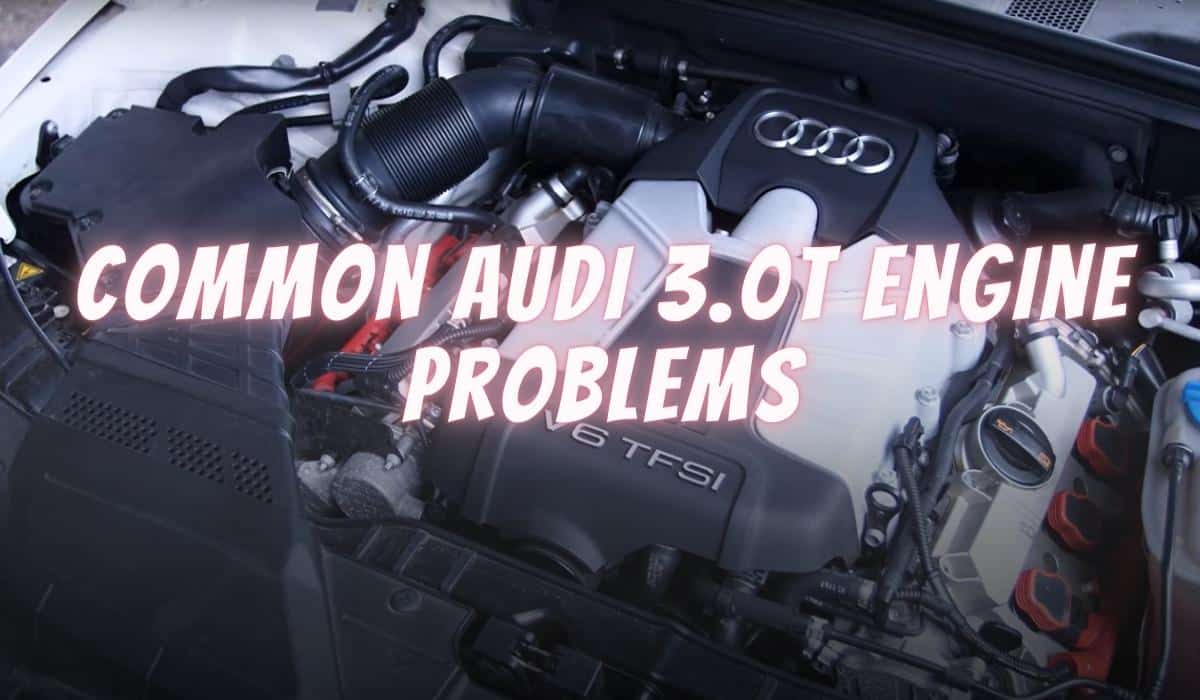
Audi 3.0T Engine Problems: Complete Supercharged V6 Troubleshooting Guide
Key Takeaways
| Problem | Main Symptoms | Possible Causes |
|---|---|---|
| Timing Chain System Failure | Rattling noise on startup | Worn tensioners & guides |
| Excessive Oil Consumption | Low oil levels, blue smoke | Failing PCV valve, worn piston rings |
| Carbon Buildup on Intake Valves | Misfires, rough idle | Direct injection design |
| Thermostat and Water Pump Failure | Overheating, coolant leaks | Plastic component failure |
| Supercharger Clutch/Isolator Issues | Rattling/grinding noise | Wear on the supercharger coupler |
The Audi 3.0T supercharged V6 is a celebrated engine, known for its smooth power delivery and significant tuning potential. Found in popular models like the S4, S5, A6, A7, and Q7 from roughly 2009 to 2017, it’s a fan favourite. However, this engine is not without its common, and often expensive, problems. Understanding these weak points is key to reliable ownership.
Audi 3.0T Supercharged Engine Specifications
| Specification | Details |
|---|---|
| Engine Code | CCBA, CAKA, CGWC, and others |
| Displacement | 3.0L (2,995cc) |
| Configuration | 90° V6, Supercharged |
| Fuel System | FSI - Direct Injection with Supercharging |
| Power Output | 200-260 kW (268-349 hp) |
| Torque Output | 400-500 Nm |
| Production Years | ~2008-2017 |
1. Timing Chain System Failure
Causes
- Plastic Tensioners & Guides: The primary failure point. The plastic guides become brittle with heat and age, cracking and breaking apart.
- Tensioner Failure: The hydraulic tensioners can fail, losing their ability to keep the four timing chains properly tensioned.
- Long Oil Change Intervals: Infrequent oil changes lead to sludge and oil pressure issues, starving the tensioners.
Symptoms
- “Death Rattle”: A loud rattling or chain-slapping noise from the back of the engine for 2-5 seconds on a cold start.
- Persistent chain noise at idle once the problem becomes severe.
- Check engine light with timing correlation fault codes (e.g., P0018, P0019).
Solution
- Complete timing chain service is required. This is an engine-out job.
- Replace all four chains, all plastic guides, and all hydraulic tensioners with updated OEM parts.
- It is critical to use the latest revision parts from Audi to prevent a repeat failure.
DIY Difficulty / Hours
- Timing Chain Service: Engine-out job, Extremely High difficulty / 40-50 hours
- Professional Repair: R40,000 - R70,000+ due to the labor-intensive nature of the job.
Critical Warning
The “death rattle” on startup should never be ignored. A failed timing chain guide can cause the chain to jump, leading to catastrophic engine damage from piston-to-valve contact.
2. Excessive Oil Consumption
Causes
- PCV Valve Failure: The Positive Crankcase Ventilation (PCV) valve, or oil separator, is the most common cause. Its internal diaphragm tears, causing the engine to suck oil from the crankcase directly into the intake.
- Worn Piston Rings: A less common but more serious issue, particularly on higher-mileage or poorly maintained engines.
Symptoms
- Needing to add oil frequently between changes (e.g., 1 litre every 1,500 km).
- Blue smoke from the exhaust, especially on startup or under acceleration.
- A “honking” or “whistling” noise at idle when the PCV valve fails completely.
Solution
- First, replace the PCV valve. This is a relatively simple and inexpensive part to replace and often solves the issue.
- If consumption persists, a compression and leak-down test is needed to diagnose piston rings, which requires an engine rebuild to fix.
DIY Difficulty / Hours
- PCV Valve Replacement: Low difficulty / < 1 hour
- Piston Rings: Engine rebuild, Extremely High difficulty / 50+ hours
- Professional Repair: R4,000 - R7,000 for PCV valve replacement. R50,000+ for piston ring replacement.
3. Carbon Buildup on Intake Valves
Causes
- Direct Injection: Because fuel is injected directly into the cylinder, it never washes over the back of the intake valves. Oil vapor from the PCV system bakes onto the hot valves, forming thick carbon deposits.
Symptoms
- Misfires at idle or under light load, often feeling like a slight stumble.
- General loss of performance and reduced fuel economy.
- Check engine light with misfire codes.
Solution
- Walnut Blasting: The most effective method. A specialized machine blasts crushed walnut shells into the intake ports to safely scrub the carbon off the valves without damaging the engine.
- Manual scraping is possible but is extremely time-consuming and less effective.
DIY Difficulty / Hours
- Walnut Blasting: High difficulty (requires special equipment) / 5-8 hours
- Professional Repair: R5,000 - R8,000.
Maintenance Tip
Carbon cleaning is considered a regular maintenance item for the 3.0T engine, typically required every 80,000 to 100,000 km to maintain optimal performance.
4. Thermostat and Water Pump Failure
Causes
- The thermostat housing and water pump are made of plastic and become brittle over time, leading to cracks and leaks.
- The internal seals of the water pump can fail, causing coolant to leak from its weep hole.
Symptoms
- Engine running hotter than usual or overheating.
- A low coolant warning light on the dashboard.
- Visible pink or purple coolant (G12/G13) residue around the front of the engine or under the supercharger.
Solution
- Replace the thermostat and water pump at the same time, as they are located together and often fail around the same time.
- It is highly recommended to use OEM or high-quality OEM-equivalent parts to avoid premature failure of cheaper alternatives.
DIY Difficulty / Hours
- Thermostat & Water Pump: High difficulty (supercharger must be removed) / 6-8 hours
- Professional Repair: R10,000 - R18,000 including parts and labor.
5. Supercharger Clutch/Isolator Issues
Causes
- The internal clutch mechanism or the torsional isolator (coupler) within the supercharger’s snout can wear out.
Symptoms
- A rattling, grinding, or “bag of marbles” sound from the front of the engine, specifically the supercharger.
- The noise is most apparent at idle and may change or disappear at higher RPMs.
Solution
- The supercharger snout needs to be rebuilt with a new isolator/coupler kit.
- This is a specialized job but can be done without replacing the entire expensive supercharger unit.
DIY Difficulty / Hours
- Supercharger Snout Rebuild: High difficulty / 4-6 hours
- Professional Repair: R8,000 - R15,000 for a snout rebuild.
FAQ
Is the Audi 3.0T supercharged engine reliable?
It can be, but it requires diligent and expensive maintenance. The timing chain issue is a major financial risk. If that has been addressed with updated parts, and oil consumption is under control, the engine itself is quite robust.
Is the 3.0T engine turbocharged or supercharged?
It is supercharged, not turbocharged. While Audi sometimes uses “TFSI” terminology where the “T” refers to forced induction in general (which can cause confusion), this engine specifically uses an Eaton supercharger nestled in the V of the engine, making FSI (Fuel Stratified Injection) with supercharging the more technically accurate description.
How can I prevent the “death rattle”?
The best prevention is strict 8,000-10,000 km oil change intervals using high-quality, VW/Audi 502.00 specification oil. This helps maintain oil pressure and protects the plastic guides.
Conclusion
The Audi 3.0T supercharged V6 is a fantastic engine when it’s working correctly, but it has several very expensive potential failure points. Any potential buyer should budget for a timing service unless there is concrete proof it has been recently completed with updated parts. For current owners, listening carefully for the startup rattle and monitoring oil consumption are key to catching problems early. While demanding, a well-maintained 3.0T can provide many years of thrilling performance.
For owners facing a worst-case scenario, Engine Finder can help source a quality used Audi engine for sale from a network of trusted recyclers in South Africa.
References and Further Reading
Important Disclaimer
This content is for informational purposes only and is based on research from automotive industry sources. Engine Finder is not a certified automotive repair facility. Always consult with qualified automotive professionals before performing any repairs or maintenance. Improper repairs can result in personal injury, property damage, or vehicle malfunction. We assume no responsibility for actions taken based on this information.
